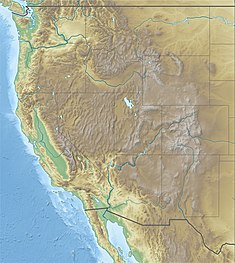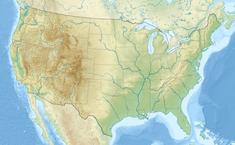Grand Coolie Dam
| Grand Coulee Dam | |
|---|---|

The dam as viewed from near the visitor center
|
|
|
Location of the dam in the western U.S.
|
|
| Country | United States |
| Location | Grant / Okanogan counties, near Coulee Dam and Grand Coulee, Washington |
| Coordinates | 47°57′21″N 118°58′54″W / 47.95583°N 118.98167°WCoordinates: 47°57′21″N 118°58′54″W / 47.95583°N 118.98167°W |
| Purpose | Power, regulation, irrigation |
| Status | Operational |
| Construction began | July 16, 1933 |
| Opening date | June 1, 1942 |
| Construction cost | Original dam: $168 million Third Powerplant: $730 million |
| Operator(s) | U.S. Bureau of Reclamation |
| Dam and spillways | |
| Type of dam | Concrete gravity |
| Impounds | Columbia River |
| Height | 550 ft (168 m) |
| Length | 5,223 feet (1,592 m) |
| Width (crest) | 30 ft (9 m) |
| Width (base) | 500 ft (152 m) |
| Dam volume | 11,975,520 cu yd (9,155,942 m3) |
| Spillway type | Service, drum gate |
| Spillway capacity | 1,000,000 cu ft/s (28,317 m3/s) |
| Reservoir | |
| Creates |
Franklin Delano Roosevelt Lake Banks Lake |
| Total capacity | 9,562,000 acre·ft (12 km3) |
| Active capacity | 5,185,400 acre·ft (6 km3) |
| Catchment area | 74,100 sq mi (191,918 km2) |
| Surface area | 125 sq mi (324 km2) |
| Power station | |
| Commission date | 1941–1950 (Left/Right) 1975–1980 (Third) 1973–1984 (PS) |
| Type | Conventional, pumped-storage |
| Hydraulic head | 380 ft (116 m) |
| Turbines | 33: 27 × Francis turbines 6 × pump-generators |
| Installed capacity | 6,809 MW 7,079 MW (max) |
| Capacity factor | 36% |
| Annual generation | 20.24 TWh |
|
Website http://www.usbr.gov/pn/grandcoulee/ |
|
Grand Coulee Dam is a concrete gravity dam on the Columbia River in the U.S. state of Washington, built to produce hydroelectric power and provide irrigation water. Constructed between 1933 and 1942, Grand Coulee originally had only two powerhouses. The third powerhouse, completed in 1974 to increase energy production, makes Grand Coulee the largest power station in the United States by nameplate-capacity at 6,809 MW. However, in terms of yearly power production, Grand Coulee places fifth after a number of nuclear facilities to the south, like Palo Verde west of Phoenix. This is because river flow varies throughout the year. For example, while the dam may generate at nameplate-capacity in the spring, decreased river flow in the fall means less power can be generated the rest of the year, resulting in a lower capacity factor.
The proposal to build the dam was the focus of a bitter debate during the 1920s between two groups. One group wanted to irrigate the ancient Grand Coulee with a gravity canal while the other pursued a high dam and pumping scheme. The dam supporters won in 1933, but for fiscal reasons the initial design was for a "low dam" 290 feet (88 m) tall which would generate electricity without supporting irrigation. That year, the U.S. Bureau of Reclamation and a consortium of three companies called MWAK (Mason-Walsh-Atkinson Kier Company) began construction. After visiting the construction site in August 1934, President Franklin Delano Roosevelt began endorsing the "high dam" design which, at 550 ft (168 m) high, would provide enough electricity to pump water into the Columbia basin for irrigation. The high dam was approved by Congress in 1935 and completed in 1942. The first waters over-topped Grand Coulee's spillway on June 1 of that year.
...
Wikipedia


